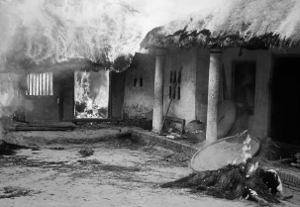My Lai Massacre was the mass murder of as many as 500 unarmed civilians, in which most of them were women, children, infants, and elderly people, in My Lai, South Vietnam on March 16, 1968 during the Vietnam War. The massacre was committed by U.S army soldiers of Charlie Company, 11th Brigade, America Division.
The soldiers were on the “search & destroy” mission to root out the Viet Cong who were thought to hide in My Lai – a hamlet of Son My Village. Yet they encountered no enemy fighters at all. In fact, no single shot was fired at the Charlie Company soldiers. The mission’s target 48th NLF Battalion was nowhere near the hamlet. However, the U.S soldiers suspected NLF forces were hiding underground and went shoot at where they suspected to have the enemy. A group of around 80 civilians were first killed by the 1st Platoon, led by Second Lieutenant William Calley, who also participated, in the center of the village. Elsewhere, other atrocities continued in chains. Some women were gang-raped. Other were beaten, tortured and their bodies were later found to be mutilated. Within 3 hours of the morning, more than 500 civilians were killed by all three Platoons of Charlie Company, although Hugh Thompson and his helicopter crews intervened and saved an approximately dozen lives.
The massacre was covered up for more than a year until Ridenhour – a soldier of 11th Brigade penned his concern about what happened in My Lai to Congress, leading to a special investigation into the event. Whilst 26 U.S. officers and soldiers were initially charged with their criminal offences in My Lai, only Calley was convicted. His sentence was adjusted from life in prison to only 3 and one-half years under house arrest. Nearly 40 years later, on March 16, 2008, Calley publicly apologized for the massacre in a talk to Kiwanis Club in Columbus, near Fort Benning, where he was convicted.
The My Lai massacre became a turning point in the U.S public perception of the Vietnam war. It sparked global outrage and massive anti-war movements in U.S, which later led to the “Vietnamization” strategy of President Nixon. Washington maintained they could still win the war. However, on the ground morale of its remaining troops in Vietnam after thestrategy had taken placed, was low. Many of them were annoyed, frustrated and addicted to drugs as a result. The murder also stands as one of the darkest days in American’s military history, questioning the American way of war from its military leadership, training to morale of soldiers in Vietnam.
